Of all the reasons to become a beekeeper, to clean beekeeping equipment isn’t one.
We like to watch bees as they go about their business, fascinated by their bags of pollen. But, when we close that lid, we have other responsibilities as beekeepers.
One of those responsibilities that beekeepers have to contend with is cleaning their equipment and other tools.
Why do we Clean Beekeeping Equipment?
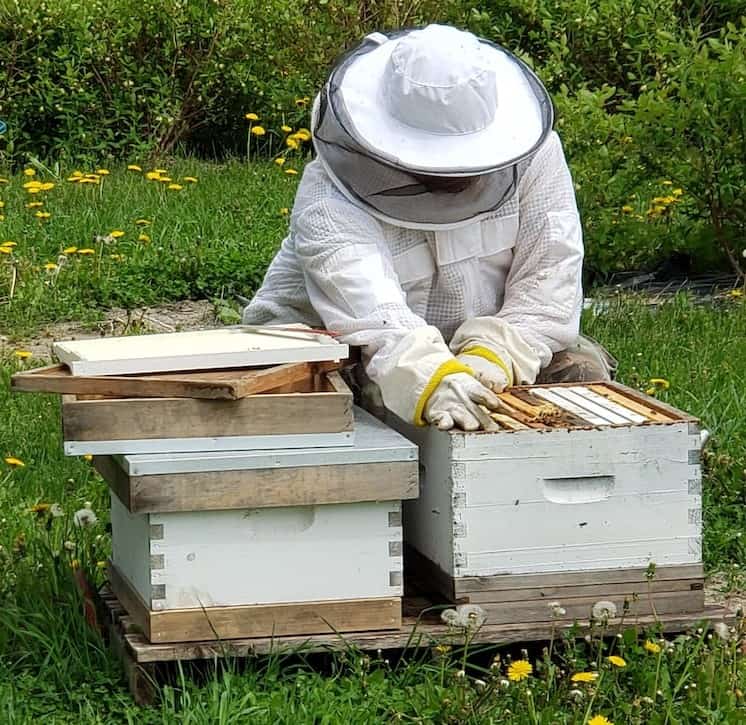
Why do you clean your house?
You do it to make it habitable and avoid that judgmental look from your mother-in-law.
In beekeeping, cleaning is not about aesthetics. There’ll be stains that just won’t come off. But, even when you can get honey, wax, and propolis off your equipment, it can leave a mark.
So, if it won’t look clean, why bother?
We clean to avoid cross-contamination. Bees have pests and diseases that spread across hives. If you don’t clean your equipment, you can turn into a vector, spreading spores and pests to an otherwise healthy colony and causing disease.
In this article, we will show you how to clean different items of beekeeping equipment and your apiary.
How do you clean a bee suit?
Your first shield of defense against bee stings is your suit, veil, and gloves. They are all made of different materials. That’s why we’ll handle them separately.
Bee suits are made of cotton, nylon, or a polyester blend. Most bee suits are white or a light color to help keep you cool as you go about your work. Each material calls for a different treatment.
How do you machine wash your bee suit?
Follow the instructions on the label. If you have a hooded veil attached to your suit, tuck it into the sleeve and zip it up. It keeps the veil in place and keeps it from ripping while in the machine.
Use washing soda to cut through the wax and propolis to get those bits off your suit.
How do you hand wash your bee suit?
The materials are the same, but you have the freedom to get a soft brush or a scrubbing aid to help you get rid of stubborn chunks of propolis. In addition, you can soak the suit for about 20 minutes to allow the washing soda and soap to soften the dirt, making it easier to scrub off.
Once they are clean, let them air dry outside.
How often should you clean your suit?
It depends on how often you wear and use it. It’s easier to keep it clean if you wash it as soon as you finish up in the apiary.
However, sometimes we get tired and ball up the suit and forget about it for weeks, especially in winter. That’s when you get mildew, which is stinky and leaves stains that are difficult to remove.
Some stains are difficult to get out of, but that shouldn’t worry you. The bees don’t care. Wash off the alarm pheromone and rinse away any chemical smells from your suit that may irritate your bees.
For synthetic material, avoid using hot water. The washing soda is quite effective. Remember to use gloves to protect your skin when using washing soda.
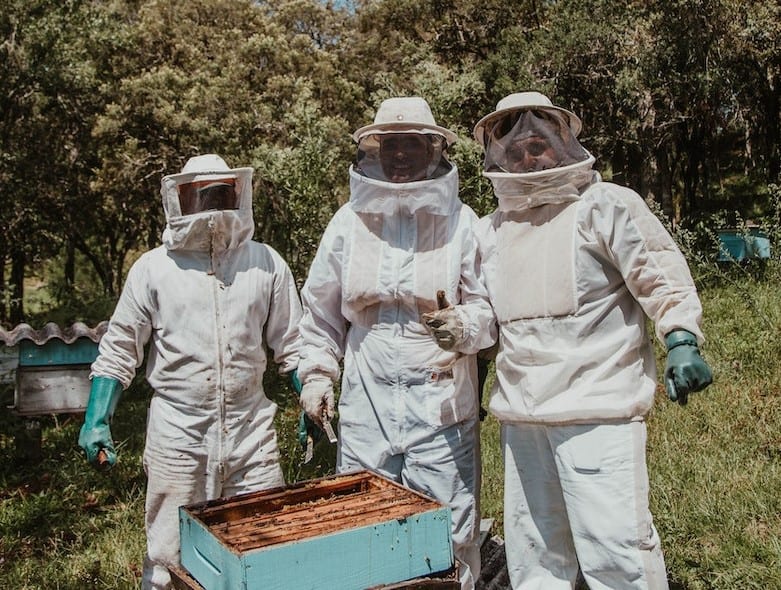
How do you clean a beekeeping veil?
Sometimes, beekeeping veils are attached to the bee suit. Hooded veils, for example, are often part of the suit. When this is the case, follow the instructions on the clothing as regards cleaning it.
Bigger veils may be purchased separately and should be washed separately. The mesh is delicate and rips easily. That’s why we recommend handwashing your veil.
Soak your hat and veil for a few minutes to loosen any dirt. Scrub the cotton section (the part that is not the veil) with a light brush for stubborn stains.
Let it air dry, possibly inside the room or under a shade. Drying a dark-colored veil under the sun may cause it to bleach and change its color.
How do you clean your beekeeping gloves?
Beekeeping gloves bear the brunt of bee stings when you are working in the hive. The stings release a pungent pheromone that lingers on your glove. If you leave your gloves unwashed, the welcoming bee party will be very aggressive during your next visit.
How do I wash Nitrile/synthetic gloves?
You can wash nitrile gloves with soap and water or dispose of them after your hive visit or harvest. They can also be machine washed, but don’t put them in the dryer. They can melt and ruin your clothing and the dryer.
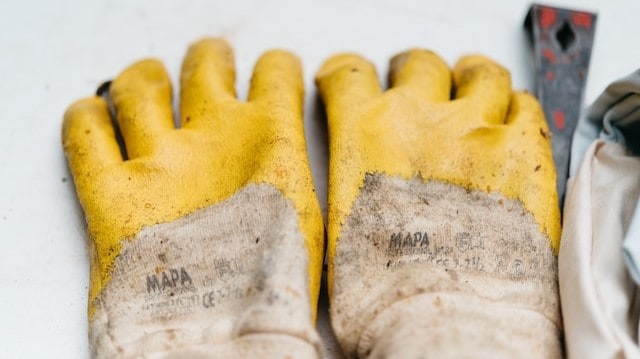
How do I wash my work or fabric gloves?
Scrape off honey using a plastic spatula or something similar. Avoid pushing it into the fabric.
Soak the gloves in hot water and some liquid detergent. If the stains persist, you can use bleach. The truth is, they are unlikely to look as good as new, but they’ll get clean enough to get you through the season.
If you use bleach, ensure you rinse well and dry them in the sun. You can also use the white vinegar that we talk about in the cleaning smoker section.
How do I wash my leather gloves?
Leather gloves are the Spiderman of the beekeeping gloves. They provide great protective power, but they require a lot of cleaning responsibility.
Soak them in cold chlorine water. That will help to loosen the stains and the wax.
Rinse the chlorine out thoroughly and wash the gloves with warm, soapy water.
Dry them in the sun. They’ll get stiff as they dry, so consider conditioning them with oil before they are completely dry.
How to clean your beekeeping tools (hive tool, bee brush)
The hive tool helps beekeepers get through that sticky propolis barrier that the bees use to keep their hive sanitized.
Hive tool
Cleaning the hive tool is a simple three-step process:
- Step 1 – Scrape off the propolis and wax with another hive tool or screwdriver
- Step 2 – Use a blow torch to heat the hive tool. That melts the propolis and wax.
- Step 3 – Wipe the melted wax and propolis with a rag, and presto, clean hive-tool
Bee brush
Wash the bee brush with some soap and warm water to help dissolve and remove any honey.
How do you clean a smoker?
It is easy to overlook your bee smoker when thinking of cleaning your equipment. We intentionally fill them with dry leaves and set them on fire.
As long as you remember to pour out the ash and blackened remains of your fuel, you should be okay, shouldn’t you? Not quite.
With time, the soot will accumulate and block airways, or worse, ignite and cause you to blow smoke into the hive, sometimes with bits of glowing particles that can damage the hive or your suit. An important step is to scrape off as much soot as you can.
There are two ways you can clean your smoker.
First, get some white vinegar and pour about a cup of vinegar into a bucket. Fill the rest of the bucket with hot water. The vinegar breaks through the oil that acts as an adhesive for the soot to cling to your smoker.
Position your smoker so that the air hole is not in contact with water. You can suspend it using any thick string or rope that will keep it in place.
Pour in the water until it is just under the air hole. Leave it for about 12 hours. Then, wash it out.
Second, use creosote remover with your desired fuel. Choose a slow-burning fuel that burns hot. The hotter it gets, the better it cleans. Keep the smoker on for a few hours.
It is best done outdoors or using something with a chimney. No scrub, no fuss.
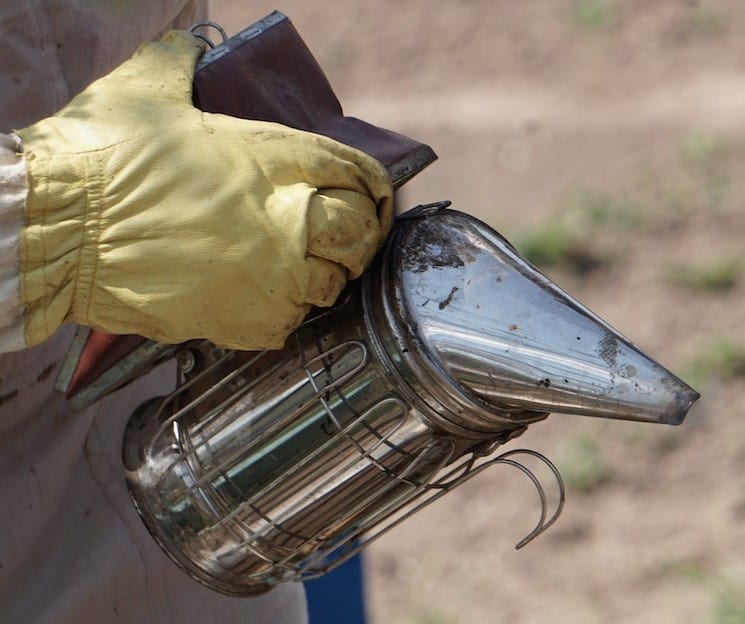
How do you clean a beehive?
How you clean the hive depends on the material used to make the hive. We have wooden hives and poly hives. Poly hives are made of polystyrene and have increased in popularity recently. They are lighter and better insulated, making them ideal for areas with long winters.
There is not much you need to clean in a colonized hive. You can cut off the burr comb or scrape off the propolis seal. The bees do a pretty good job of keeping things tidy in the comb.
Previously occupied hives need to be cleaned before you install a new colony.
Maybe you have a colony that did not make it through the winter. Sometimes bees abscond with their queen and leave a drawn comb that attracts wax moths.
It is vital to diagnose what caused them to leave. If the colony was riddled with disease, you need to do more work to sterilize your equipment and tools. If the problem was foulbrood, you probably would have to destroy the hive.
How do you clean wooden hives?
When cleaning a wood hive, take out the frames which you will handle separately. Scrape off any dead bees and debris.
Use either boiling water or a blow torch to sterilize the hive.
If you choose the blowtorch, you need to scorch (not burn) the surface of the wood, paying particular attention to the corners. That is where pests like wax moths choose to lay their eggs.
You can also use boiling water if you do not have a blow torch. Using a kettle, bring the water to a boil and pour a steady stream of that hot water all over the wood hive. Once again, concentrate thoroughly on those corners. The water must be scalding hot, so be careful. Air dry before you put it away for storage.
How do you clean plastic/polystyrene hives?
Wash and scrub with washing soda and soap. Poly hives are relatively easy to clean and dry. They are also durable since water damage is unlikely.
How do you clean frames?
Freeze drawn-out frames for at least 24 hours before storing them to kill any wax moth eggs. When you take them out of the freezer, wrap them in plastic and keep them in a cool, dry place.
If you suspect foulbrood, you will have to destroy the frames as well.
Sometimes, the wax moths get to your frames before you do, scraping off all the webbing and remaining wax. Then dip them in boiling water or scorch them to kill any eggs and then store them.
How do you clean flow hive frames?
First, let the bees have a turn. Leave the frame in the hive for a day or two and let the bees do the first clean-up. Next, remove the frame from the hive, adjust the frame so that the cells open, and spray it down with hot water. Ensure they are completely dry before you put them in storage.

How to clean your honey harvesting equipment (Extractor and double strainer)
Honey is sticky and leaves quite a mess. Fortunately, it is soluble in water.
The tricky thing about honey is it absorbs smells and flavors, so you have to be careful about what you use to clean your equipment.
How do you clean a honey extractor?
All you need is water and a scrapping tool.
First, use cold water to rinse your equipment. This hardens the bits of wax in the honey extractor or on the sieve and uncapping fork. By then, you could thoroughly scrape off the wax.
Then, heat up some water and use this to dissolve all the remaining honey. Fill the extractor with water and leave it sitting overnight. In the morning, pour out the water and empty out the extractor.
How do you clean a double strainer?
The double strainer is something we use to make honey marketable. Also, a bee on the tongue can mess up the sweet experience.
Your extraction method determines how much wax and propolis you will need to strain out of the honey. Nevertheless, there will always be bits of wax that will clog up the holes in your sieve.
Since it is made of stainless steel, there are several options for washing the sieve.
First, use warm water to dissolve the honey. Burning water is not necessary. Heat the water just enough to melt the hardened honey.
Once the honey is gone, switch to cold water. Scrub the sieve with a scouring pad under running water. Make sure you rinse the sieve upside down so that the wax is pushed off the mesh into your sink.
Repeat this whole process when necessary. And, for stubborn propolis chunks or any other debris, you can use rubbing alcohol.
How to clean your apiary

Strictly speaking, an apiary is not an equipment, but it is a valuable asset. Keeping the apiary tidy reduces pest accessibility, specifically ants, and makes inspections easier for any beekeeper.
Keep the weeds short so that insects do not use them as a bridge into the hive. Trim hanging branches to avoid attacks from above and keep twigs from snagging your beekeeping veil.
Cleaning equipment may not be fun, but these tips make it a little easier. If you have any additional tips, let us know in the comment section below. We’d love to hear from you.
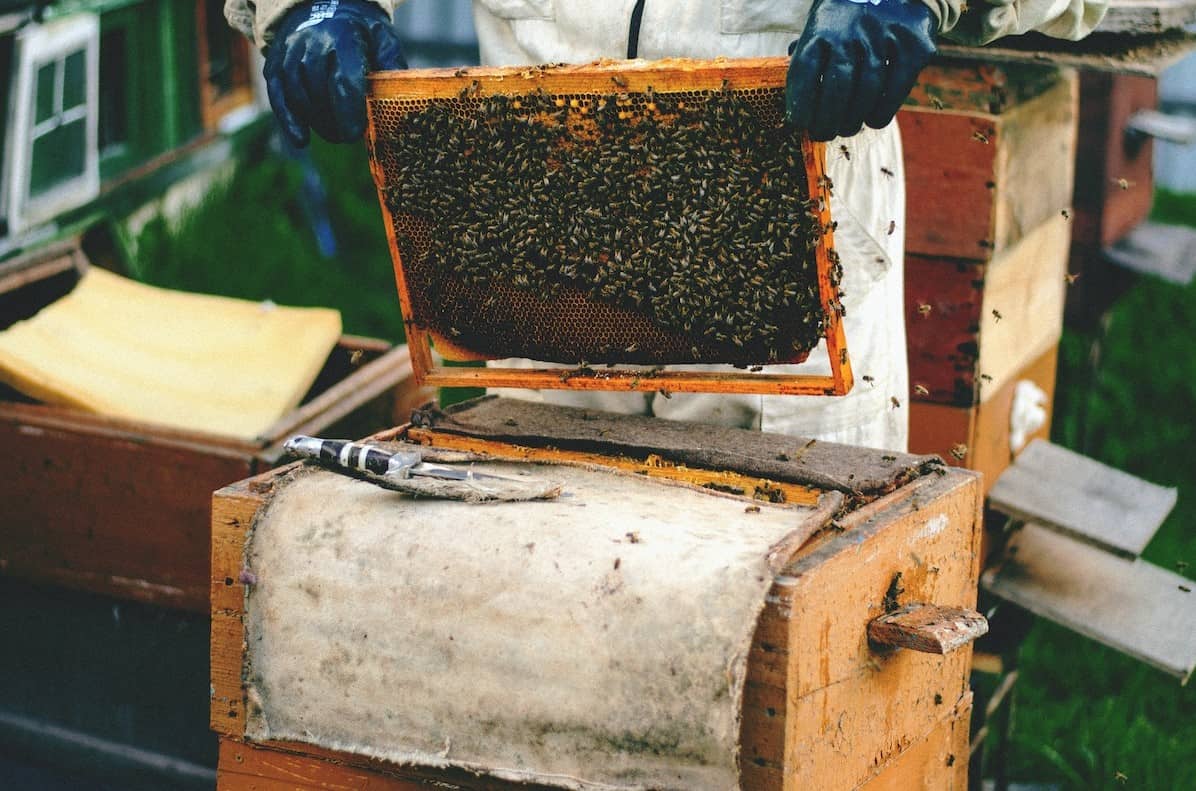

How do you clean the Mason jar feeders? Is it okay to use soap?